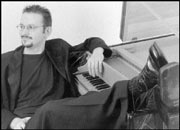PIANIST BYRON SCHENKMAN
Town Hall, Eighth and Seneca, 325-6500, $18 8 p.m. Fri., Sept. 6
AS A HARPSICHORDIST, Byron Schenkman has been lauded in periodicals ranging from the American Record Guide to The Advocate. About to begin his eighth season as co-director (with Ingrid Matthews) of the Seattle Baroque Orchestra, he’s making his “modern piano debut” with a program of Haydn, Schubert, Mendelssohn, and Moscheles.
Seattle Weekly: Why did you decide to do this? Because you got tired of the narrow harpsichord repertory?
Byron Schenkman: [Laughs] In spite of the fact that there’s way more solo repertory for harpsichord than for modern piano. . . . I like to keep getting different perspectives on music, because I think we can get really stuck in our preconceived notions, our own language and our own little rules about how music works—but our audience doesn’t; our audience comes from a lot of different backgrounds.
I entered [the New England Conservatory] as a pianist. [But] I always wanted to play harpsichord. . . . I think it served as a sort of adolescent rebellion, because I grew up in a background where if you weren’t going to be a doctor you could be a classical musician, but you should be a pianist or a violinist or a conductor. . . . [Laughs]
Wasn’t the harpsichord cool enough?
I think it was a little too rarefied. Probably too queer, basically. So I rejected the piano for a few years, and then decided to start lessons again and audition for the master’s program [at the University of Indiana] in piano, and actually got admitted with the highest rating, even though my bachelor’s degree had been in harpsichord. So I did a lot of soul-searching; my feeling at the time was that as a harpsichordist I could be one of the best, [but] as a pianist. . . . There are so many wonderful pianists, and so many people trying to make careers. I’ve worked pretty single-mindedly and with a lot of conviction at building a career as an early keyboard player. And 10 years out I’ve realized I’ve basically achieved that goal—I am, I think it’s safe to say, one of the best harpsichordists in the world, and I get the recognition I would want for that. So I’m ready for the next challenge.
But you’re still playing music that is associated with early instruments, at least fortepiano. It’s not as if you’re jumping ahead to music that is suitable only for the modern piano.
I would like to get to that repertoire soon—music that I can’t play on historical instruments because that [the modern piano] is the historical instrument.
What are your views on playing 18th-century music and earlier on the modern piano? Maybe it’s a non-issue?
Scarlatti is a good example. . . . After I recorded this Scarlatti disc [his latest CD release], I started listening to lots of other people, and in general my favorite Scarlatti recordings are on modern piano, specifically Horowitz. [His playing] just seems really personal and honest. . . . He takes his own imagination and musical soul, and he makes this beautiful thing. It’s not the way I would play the sonatas on harpsichord—it’s probably not the way anybody would—it doesn’t have anything to do with that [baroque performance practice], but it’s great music.
I like strong artistic statements . . . musicians who aren’t afraid to take risks and do things their own way. The one thing I know I don’t want to do is be “correct”—”OK, now I’m going to do the complete Beethoven sonatas as he intended. . . .” But we don’t have an authentic audience. Because they [audiences in Beethoven’s day] didn’t have remote control. [Miming short-attention-span channel-surfing] Zap! “Boring!” Zap! “Boring!” They were used to sitting through things.







